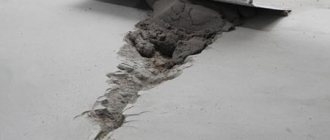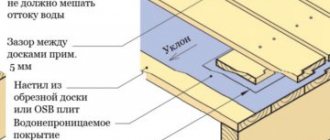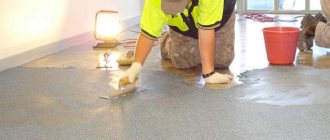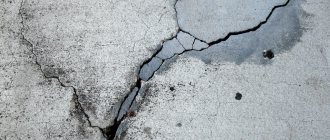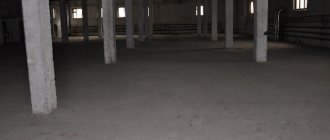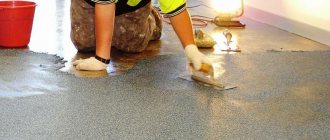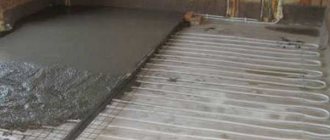Repair compounds for concrete can eliminate deformations and chips in structures. The products are used in different seasons, withstand changes in temperature conditions, are resistant to high humidity, the effects of fungus and mold, have good adhesion and rapid setting of the composition.
The list of popular products includes products from the brands Emaco, Consolit Bars, Birss, Siltek, Knauf, Mapei.
Difficulties of the concrete repair process
Repair of concrete surfaces using mortar or dry mixtures is required when the reinforcement is exposed, the material is destroyed, or the surface cracks down to the crushed stone filler. In the absence of restoration work, the structure may collapse.
There are the following difficulties in repairing concrete structures:
- cement grain has a dense structure and does not absorb liquids, solutions, standard masonry composition does not adhere to the base;
- The typical repair mixture shrinks and peels off on a concrete base.
To restore the integrity of the surface, specialized mixtures are used that are characterized by plasticity, a high degree of adhesion, and strength.
The product formula includes the following basic principles:
- dry polymer-cement and ready-made compositions;
- fibropolymer compounds consisting of sifted sand, acrylic and cement;
- compositions with epoxy resins.
General requirements for preparatory work
- Mechanical preparation of surfaces. This is the use of a sledgehammer, chisel, hammer, hammer drill and other tools with which you can remove weak, loose concrete.
- It is possible to use sandblasting machines.
- Hydraulic preparation using high-pressure water jets with a power of up to 250 Bar.
- Also, for smooth surfaces with closed pores, it would be useful to use chemical preparation. Treatment of the base with impregnations, such as Himfrez. This method can be used instead of the mechanical method.
Classification
Repair composition for sealing cracks in concrete is divided into the following types:
- injection molding;
- dry.
To adjust the characteristics, plasticizers, granular fillers, modifying additives, etc. are added to the mixture.
According to the complexity of the composition formula, products are divided into the following subtypes:
- one-component - cement-based with filler of different granularity levels;
- two-component - epoxy differ in the degree of density, ductility and fluidity;
- multicomponent - based on polyurethane, have a liquid consistency.
According to the level of compression, products are divided into the following subtypes:
- shrinkage;
- non-shrinkable.
According to their functional purpose, the following subtypes are provided:
- for structures with high mechanical loads - ceilings, load-bearing wall panels, beams, pillars;
- compositions for protecting reinforced concrete structural elements from corrosion, the appearance of fungus, and damage from mold;
- Products with increased strength for the restoration of road surfaces and building screeds provide additional protection in winter.
According to the conditions of use, products are divided into the following subtypes:
- casting - for horizontal surfaces;
- thixotropic - for correcting unevenness on wall panels;
- frost-resistant - for external repair work;
- quick-hardening - for urgent repair work, eliminating leaks.
Fast acting mixture
Fast-acting concrete repair mixtures harden and dry quickly. The use of heavy loaders is permitted 30 minutes after application of the composition. The mixtures are suitable for a concrete layer no larger than 40 mm. The materials are used for emergency repairs in warehouses, in places where equipment is not allowed to remain idle.
Non-shrink repair product
Shrinkage occurs when the volume of cement stone in the solution decreases during the evaporation of water from the adhesive composition. Deformations can lead to the formation of cracks and chips. A special non-shrinking composition prevents destruction of the concrete base.
The formula of the product includes additives with a special reagent to expand the mass.
The solution is plastic, does not separate, does not shrink and sets quickly. The compositions are suitable for different types of bases, are strong, durable, and are highly expensive.
Thixotropic mixture
The thixotropic mixture is intended for repairing blocks, wall panels on a slope, and horizontal surfaces. When using the product, no auxiliary lathing is required; the product has a high viscosity that prevents spreading outside the treated area.
The dry mixture is based on durable cement powder, mineral fillers, and modifying agents. The mass also includes reinforcing fibers.
After dilution in water, a strong solution is formed that does not create shrinkage. The thixotropic mixture must be applied in a dense layer. For stability in places with heavy loads, reinforcing bars will be required. After hardening, the composition becomes resistant to compression and bending, and vapor permeable.
The product is intended for professional repairmen and restoration work in private buildings.
When used professionally, the mixture is suitable for the following areas and types of structures:
- restoration of damaged surfaces, structural repairs in the event of reinforcement corrosion;
- to eliminate defects that arose during construction;
- to restore the protective layer;
- for filling thin seams;
- for leveling wall panels and fences;
- for mounting foundations exposed to strong mechanical loads;
- for waterproofing work on the roof;
- for repairing boiler houses, thermal power plants, bridges, chimneys, viaducts;
- for restoration of ceilings in basements.
In private construction, compositions are used in the following cases:
- repair of concrete floors, paths, floors, staircases, basements, vegetable stores;
- sealing cracks, chips, grooves;
- restoration of garages;
- repair of structures subject to dynamic loads.
Thixotropic repair materials are not used for finishing smooth surfaces and are not suitable for anchoring or preparing formwork. The installation temperature must exceed +5°C. The thickness of 1 coating reaches 30-35 mm, after 28 days the compressive strength reaches 60 N/mm², elasticity parameters are 25,000 N/mm².
Frost-resistant
Frost-resistant compounds are used to repair concrete outdoors. The product can withstand sub-zero temperatures and temperature changes. The formula of the mixture contains polymer compounds, minerals, fractionated sand, modifying fillers, Portland cement, etc.
The product is used for repairing brick and concrete buildings, cracks in floors, technological holes, restoring smoke, boiler houses, thermal power plants, prefabricated reinforced concrete structures, plinths, for waterproofing building foundations, eliminating defects in monolithic structures, etc.
What are the advantages of penetrating waterproofing over rolled and mastic materials?
Scheme of the operating principle of penetrating waterproofing
The foundation is the most important element, the basis of any structure. And if it is not reliably protected from the effects of adverse factors, the service life of the building will be significantly reduced. The effect of groundwater on an unprotected concrete foundation can result in this period being reduced to several years. After which the house will gradually begin to collapse: humidity will reign in the rooms, cracks will begin to appear on the walls, and mold will grow in the dark corners. The proximity to woodlice and mold colonies can hardly be called pleasant, but these are still “flowers”. The impact of groundwater on the foundation can lead to the collapse of the building - this is really serious.
To avoid a sad scenario, at the stage of constructing the foundation, care should be taken to ensure its reliable waterproofing. The use of special roll coatings and bitumen mastics does not completely solve the problem.
Disadvantages of mastics and roll materials in comparison with penetrating waterproofing:
- Rolled and mastic materials protect the structure only from the application side;
- Any defect or damage to the protective layer can lead to moisture penetration into the concrete surface;
- The presence of seams in rolled insulation is its most vulnerable point, therefore the material has to be laid in two layers to cover the surfaces of the seams, and this significantly increases the consumption and cost of work;
- If the groundwater level is high enough, the service life of rolled insulation may be reduced to three to five years;
- The main disadvantage of mastic waterproofing is also its fragility;
- If the work is carried out after the construction of the house, then coating and roll type insulation requires mandatory digging out of the outer wall.
Penetrating foundation waterproofing easily solves all these issues. Why? Its action is based on a completely unique principle. The composition of dry building mixtures for waterproofing may vary, but usually it is a cement mixture with the addition of quartz sand and chemicals that have the ability to penetrate deeply into the cellular structure of concrete. Where, during a chemical reaction, crystals are formed that densely fill the pores of the material from the inside. These crystals become part of the concrete structure, compacting it and preventing water from penetrating.
Applying penetrating insulation using a roller
The main advantages of penetrating waterproofing:
- At the construction stage, penetrating waterproofing of the foundation is ensured by adding a dry mixture such as Penetron Admix (or other brands) to the composition of the concrete being mixed. This changes the structure of concrete, turning it into a qualitatively different material. The foundation will be protected from the effects of groundwater throughout the entire thickness of the structure, regardless of its depth;
- Such waterproofing lasts as long as the concrete “lives”, because the material itself becomes waterproof;
- The crystals formed inside the cells have the ability to “self-heal”: if water does penetrate into the materials during operation, the formation of crystals resumes, and the concrete “heals” itself;
- The time frame for construction or repair work is reduced, because... When using penetrating waterproofing, there is no need to thoroughly dry the concrete. The mixture must be applied to a wet surface, and the higher its humidity, the faster the chemical reactions involving the active components occur;
- Concrete retains all technical characteristics: setting speed, air permeability, mobility, frost resistance, and so on. It “breathes” and remains vapor permeable. Materials treated with penetrating waterproofing mixtures significantly change only their waterproof characteristics;
- If waterproofing work is carried out after the completion of the construction phase, then this type of insulation will allow all the necessary manipulations to be carried out without digging up the foundation of the house. The structure can be processed from any side, including from the inside;
- Penetrating waterproofing is effective in any direction of water movement and level of pressure;
Penetrating waterproofing of the entire surface of the masonry, all seams and joints prevents acidic and alkaline aggressive environments, microorganisms and fungi from penetrating into the thickness of concrete; protects materials from exposure to salty sea water, groundwater and wastewater with varying levels of harmful components.
Manufacturers
The list of popular repair compounds includes products from the following manufacturers:
- Ceresite;
- Penetron;
- Basf;
- Birss;
- Consolidated Bars;
- Siltek;
- Knauf;
- Industry;
- Mapei.
Ceresit
The manufacturer Ceresit produces different types of building mixtures for concrete foundations. The Ceresit CX5 mixture is a restorative mixture, suitable for repairing concrete structures at high humidity. The product does not shrink significantly when hardened and used, and can withstand changes in temperature conditions. The coating is resistant to high humidity and reliably hides defects. The cost of the composition is high - about 2500-3000 per package of 25 kg.
The composition of Ceresit CN 88 is intended for leveling floor coverings and is durable. The product is laid out in a layer of 5-50 mm and can be used indoors and outdoors. The mass is quickly leveled, the surface can be used 6 hours after restoration. The product is wear-resistant, suitable for mechanized spraying, and environmentally friendly in composition.
The product is suitable for leveling screeds and restoring foundations that can withstand high loads. The mass is suitable for manual application to the coating.
The minimum layer thickness is no less than 35 mm; on the sound and heat insulating layers, the product is laid out with a thickness of no less than 45 mm. Can be used as a base for laying finishing material.
Penetron m500 bond mixture
Concrete repair compositions from the Penetron brand are dry mixes. The formula contains processed quartz sand, fine-grained Portland cement, polymer compounds to improve the elasticity of the product, and mineralized fiber fibers. The mixture must be diluted in the proportions of 170 g of water per 1 kg of powder. Laying the mass is carried out at a temperature of at least +5°C. The surface must be washed with clean water.
The product is laid out in a thickness of 5-35 mm, consumption is carried out in proportions of 1.8 kg per 1 m². The composition can be laid out in several layers, the second coating is applied after 4 hours. It takes 120-150 minutes for the layer to harden. After 28 days, the patch increases water resistance to W14, the strength category is 50 MPa, the adhesion level is up to 1.3 MPa.
Blend Parade
Parad brand compositions are intended for urgent repairs of concrete structures; the coating thickness can reach 60 mm. Laying can be done at a temperature not lower than +5°C. The advantage of the product is the rapid setting of the composition and the high strength of the patch.
After 1 day, the strength of the layer reaches 20 MPa; after 1 month, the coating acquires a strength parameter of 70 MPa, the frost resistance level is F200.
The product is universal, suitable for different types of structures (anchors, foundations, joints, road slabs, hydraulic structures, drinking water tanks).
Emaco
Repair mortar for concrete floors Emaco brand Basf is used for structures of various levels of complexity. Emako N 5100 is suitable for minor deformations (cracks, chips). Products N 900 and N 5200 are suitable for eliminating defects of medium complexity (cracks, collapsed areas).
Products S 5400, S 488 are used to eliminate damage due to the corrosion process, closing cracks up to 40 mm. The company also offers compositions for damaged concrete surfaces with exposed reinforcement bars and large chips.
The manufacturer has developed frost-resistant, non-shrinking, anti-corrosion compounds. The price in Moscow is 850-1800 rubles. for 1 package.
Birss Russia
The concrete repair mixture from the Birss brand is universal and can be used for surfaces of different levels of complexity. Products 28, 29, 30, 30N are applied to eliminate cracks and deformed coatings. Special products (30С1, 59С2 and 58С1) are intended for medium wear surfaces; mixtures 59S3, 59Ts, RSM, RBM, 600VRS are used in case of major damage to structures.
The compositions have frost-resistant characteristics, are used at sub-zero temperatures, have high strength of bonding of elements, have water-resistant characteristics, high density, and plasticity.
Consolid Bars
Products for surface restoration Consolit Bars are suitable for panels located vertically and on floor coverings; the mass quickly holds surfaces together, does not shrink, and has high adhesion. The product line includes self-leveling, thixotropic (for restoration of wall panels), finishing, waterproof and reinforcing mixtures. The cost of production is 800-1500 rubles. per package 30 kg.
Knauf
Products for concrete repair from the Knauf brand are environmentally friendly, do not contain toxic substances, are durable, provide surface waterproofing, and have water- and vapor-proof characteristics. The mixtures are sold in compact packages (5-6 kg). The products are universal and are used for external and internal repair work. The cost of packaging (5 kg) is 350-500 rubles.
Industry
Indastro products are universal and are used for repairs, restoration of structures on foundations, restoration of road surfaces, etc. The composition ensures strong joining of elements, is durable, wear-resistant, does not have strong shrinkage, is water-resistant, and frost-resistant.
Mapei (Italy)
The mixture from the Mapei brand ensures that restoration work can be completed in a short time, does not shrink during hardening, does not deform, and prevents abrasion of surfaces. The special SW series is suitable for reinforced concrete structures and is resistant to temperature changes, precipitation and moisture. After hardening, the coating layer acquires anti-corrosion properties and is suitable for waterproofing work.
The manufacturer's range also includes mixtures:
- epoxy;
- with the addition of resins;
- with high plasticity;
- for repairing cracks;
- for restoration of ceilings;
- for repairing airfield ceilings, tunnels, production workshops, highways.
The product price is about 850-1500 rubles.
Mount Crystal
Mountain Crystal products are intended for the reconstruction of concrete floor surfaces, reinforced concrete floors, walls lined with foam concrete and aerated concrete blocks. The mass is used to seal cracks and placed in areas of chips, holes, voids and traces of erosion. The product is suitable for restoring walls, floor coverings, and ceilings.
Siltek
The manufacturer Siltek offers a composition for repairing defects in surfaces and finishing seams between panels. The materials are frost- and water-resistant, quickly harden, durable, and wear-resistant. Reinforced microfibers are included in the formulas of some products. Products are certified.
The particle size in the mass reaches 2.5 mm, the thickness of the coating reaches 30 mm, after 3 days the strength of the layer reaches 15 MPa, after 28 days - 35 MPa. The product is suitable for use within 30 minutes after dissolving in water.
Frost resistance parameters reach at least 200 cycles, shrinkage does not exceed 1.2 mm/m, abrasion characteristics do not exceed 0.5 g/cm2.
The permissible operating temperature is -30…+70°С. After 3 days, the bending strength parameters reach 3 MPa, after 28 days - no less than 5 MPa. The strength of bonding to the surface is not less than 2.0 MPa.
Information about types of screeds
In order for the floors in the house/apartment to become perfectly smooth and suitable for installation of the finishing coating, floor screed technology is used. It is carried out using special building mixtures, which cover the rough base with an even layer - this is how you can get the most durable type of screed. There are several options for creating such a leveling layer that are used in residential premises. This is gypsum, cement, and sand concrete screed.
Floor screed mixtures
Gypsum screed has a high drying rate of the material, so it is used quite often. Usually, within 3 hours from the moment the composition is applied to the base, you can move on the treated surface, and you can lay the floor covering and carry out other work after 7 days.
On a note! The indicated times are optimal for a screed with a thickness of about 4 cm. In the case of laying a thicker layer, the time for complete drying increases. On average, for every centimeter above the first four you need to add 42 hours to dry the material.
Plaster screed
Cement screed is a traditional option that is most often used for leveling floors. But this is also the longest drying type of screed. With a thickness of 4 cm, the material will initially dry for at least a week. And, as in the previous version, as the thickness increases, the drying time of the cement layer also increases - for 1 extra centimeter, 7 days are added. And if the screed turns out to be very thick, then all of 2 weeks.
Cement floor screed with foam plastic
Sand concrete screed is, in terms of its performance, an average option between cement and gypsum. It is made on the basis of universal cement (M300). The drying time for such a screed is also long, like that of a cement screed.
Sand concrete screed
However, you can speed up the drying process of the screed. For example, add expanded clay to the solution or use it as a bedding when laying the screed layer. Also, a regular screed can be replaced with a special quick-drying one - such mixtures have been on sale for a long time. We will talk about them today.
Types of floor screed
quick-hardening self-leveling floor
How to choose?
When selecting products, the following parameters must be taken into account:
- type of repair required;
- extent of damage;
- permissible loads on the base;
- location (indoor or outdoor);
- safety, no toxic particles;
- thickness of the mass laying layer;
- volume of raw materials;
- level of protection against ultraviolet radiation;
- shrinkage characteristics;
- resistance to chemicals and sub-zero temperatures.
When choosing the type of product, it is important to consider the following recommendations from experts:
- it is better to strengthen panels located vertically with thixtotropic mixtures, since the products have a thick consistency and hold securely during operation;
- compositions for leveling the surface must have a high adhesion rate;
- The setting period of the mass should be short.
What does quick-drying screed consist of?
The quick-drying screed may contain special additives. These are thinners, pore formers, activators. All of them increase the drying speed.
Blowing agents are substances that improve the process of removing moisture from the screed. They are also a kind of stabilizer for the solution. Most often, pore formers are represented by tensides. Unfortunately, their use negatively affects the strength of the final coating.
Tensides are surfactants (surfactants), universal chemical additives that increase foaming. Used not only in construction
To compensate for the decrease in strength due to surfactants, resins are added to the mixture. Due to them, the screed is of high quality and reliable.
Accelerators , as is clear from the name of this group of substances, significantly reduce the time it takes to gain the initial and further strength of the screed. And thinners make the coating solution more plastic, which ensures uniform distribution of the mixture over the surface with a small volume of added water.
Accelerators significantly reduce the time it takes for a screed to gain strength
Also, in the production of quick-drying screed, special modified components can be used. They additionally increase the strength of the final work, reduce shrinkage rates and the risk of cracks.
On a note! There are also fast cements on sale that dry out in record time - within a day a finishing coating can be laid on them. They contain gypsum additives. However, working with them without proper skill is extremely difficult.
Quick-setting cement ARDEX SB 1
Application practice
Concrete structures are destroyed if the proportions of substances are not observed, manufacturing technology is violated, due to mechanical deformations, or exposure to the external environment.
The use of special compounds is required in the following cases:
- chips;
- recesses;
- holes exposing reinforcement;
- cracks larger than 0.5 mm;
- intensive dust formation;
- corrosion process in the foundation (deep or surface);
- defects larger than 0.3 mm.
Residual humidity values
This mysterious parameter - residual moisture - is an indicator that indicates that the screed layer has already completely dried and other work can be done on its surface. Its indicator cannot exceed certain values. Strength gain and residual moisture are different parameters. Strengthening processes take a very long time.
Residual moisture indicators can be found by referring to European standards. So, in Germany the maximum values of this indicator will be as follows:
- 2.0 CM-% – for cement floor;
- 1.8 CM-% – for cement floors with a heating system;
- 0.5 CM-% – for anhydrite;
- 0.3 CM-% – for anhydrite with a heating system.
What is residual moisture in screed
In Switzerland, the indicators are slightly different:
- 2.5 CM-% – for cement screed under linoleum, textile coverings;
- 2.3 CM-% – for cement screed under synthetic finishing materials, parquet;
- 2.0 CM-% – for cement screed under rubberized materials;
- 1.5 CM-% – for cement floors with heating elements;
- 0.8 CM-% – for anhydrite bases;
- 0.5 CM-% – for flowable anhydrite bases and anhydrite coatings with a heating system;
- 0.3 CM-% – for fluid anhydrite bases with heating.
Material for analysis must be taken from the entire depth of the screed layer - this is the only way to find out the exact indicator of residual moisture. The fact is that at depth there may be an accumulation of excess liquid.
How long does it take for floor screed to dry?
Self-production
You can make a repair composition for concrete yourself for work on the arrangement of a private house, outbuildings, etc.
You will need to mix the following components:
- 1 part cement powder;
- 3 parts clean fine sand;
- glue (PVA or Bustilat) with water in proportions 1:3.
You need to mix sand and cement powder, mix with other ingredients and prepare a homogeneous mass. When mixing, use a special mixer. The composition is prepared on the eve of work to prevent pre-hardening. The mixture is suitable for finishing floor coverings, vertical panels, etc.
Quick-drying floor screed
This type of building mixture is distinguished by the fact that the laying technology is based on the use of a minimum amount of liquid. That is, while mixing the mixture, the volume of water is strictly limited. Also, this screed may contain special accelerator substances, thanks to which the drying process goes faster.
Quick-drying screed for bathroom floors
On a note! In some cases, stores may sell a quick-drying screed as a mixture that quickly becomes strong enough to walk on. However, you will have to wait a long time for the layer to dry completely, as in the case of using conventional mixtures.
Quick-drying floor screed
Photo of quick-drying floor screed
Quick-drying screed for floors and coverings
Another photo of a quick-drying screed
Which tile grout is best?
Ceramics is one of the most versatile finishing materials. The tiles differ in composition, water absorption coefficient, and format. Tiles, porcelain tiles, and mosaics are used to cover surfaces that are exposed to aggressive influences of varying intensity. For these reasons, grout for finishing the walls of a research laboratory differs from grout intended for a kitchen in a city apartment, not only in price, but also in technical characteristics. Manufacturers are forced to produce mixtures with different parameters; it is impossible to find a universal grout. Our experts recommend the following options based on the scope of application:
- Litokol Starlike – for interior work and exclusive projects;
- Mapei Kerapoxy Design – for renovations in a swimming pool, city apartment;
- Living paint Diamond - will help create an original atmosphere at low cost;
- Ceresit CS 25 – when sealing joints between the bathtub and tiles;
- Kiilto Saumalaasti is the best solution for a good apartment renovation;
- Perel RL summer – for large volumes of finishing work.
All grouts presented in the review will help to carry out repairs taking into account the requirements of SNiP, but only grouts that are characterized by increased wear resistance and chemical resistance are worthy of the title of the best in their categories.
Screed installation
Step 1. First of all, prepare the base - remove dust, dirt, and debris. Irregularities are removed and cracks are sealed.
Preparing the base
Step 2. Heat-insulating material and sound-proofing mats are laid on the surface of the base. They are placed 15 cm on the walls. The mats are fastened together with reinforced tape. Reinforcing mesh can also be used to strengthen the layer.
Insulation materials should be placed 15 cm on the walls
Step 3. Beacons are installed. This is necessary so that the final floor level is level.
Types of guides and materials used
It is convenient to use a laser level to set beacons.
Next you need to set the beacons
Solution for fixing beacons
Installation of beacons
Step 4. In accordance with the instructions, mix the mixture for the screed using a construction mixer (for example, the proportions for quick-drying screed Thomsit SE 93 are as follows: 8.5–9.0 l of water per 25 kg of concentrate and 100 kg of filler; 10.0 –10.5 liters of water per 25 kg of concentrate and 125 kg of filler).
Mixing the screed mixture
Technical documentation - Quick-drying screed Thomsit SE 93 . Downloadable file (click the link to open the PDF in a new window).
Quick-drying screed Thomsit SE 93
Step 5. Next, the mixture is applied to the prepared base and leveled along the beacons.
Application of quick-drying mixture
Layer alignment
Step 6. Leveling the screed layer is done using the rule.
The mixture is leveled by the rule
Another photo of the process
Calculator for calculating the amount of ingredients of a mortar for floor screed
Go to calculations
Mixture cost
Name
| Weight, kg | price, rub. | |
| Coating waterproofing | 20 | 630 |
| Plaster waterproofing | 25 | 100 |
| Suture waterproofing | 25 | 130 |
| Repair mixtures | 25 | 380 |
| Water plug | 1 kg | 180 |
| Penetrating waterproofing | 25 | 180 |
| Additives to concrete | 1 l | From 80 |
Application of dry waterproofing
Only coating waterproofing mastics are produced in finished form; other types must be mixed independently. Each composition has its own instructions for preparation and use. The general rules are presented in the following table:
| 1) Mix the dry mixture with a special liquid (depending on the composition - water) until a homogeneous mass is obtained. First, pour the dry mixture into the container where the solution will be prepared, and only then add water portionwise, stirring vigorously. The mass should be as homogeneous as possible and without lumps. After letting the solution stand for 3 - 5 minutes, mix again. Use the mixture within 60 minutes of preparation. |
| 2) Using a synthetic brush, apply the prepared mixture in a thin layer onto a damp, but not wet, base. It is best to work with solutions at a room temperature from +15°C to +23°C. When preparing a new portion, you should thoroughly wash the container to remove any remnants of the previous one. |
| 3) Seal all junctions of building structures (walls and floors). To do this, round the internal corners with a mortar mixture of a thicker consistency with a radius of at least 3 cm. |
| 4) Apply sealing tape at the joints between the walls and floor. Apply a second layer of mixture on top. |
| 5) After 72 hours, you can begin facing work. |
| 6) After laying the tiles, grout the joints and treat the joints and corners with elastic silicone sealant to prevent the appearance of fungus and mold. |
Whatever type of waterproofing with dry mixtures is chosen, it should be remembered that the key to the quality of the coating is careful adherence to the technology. Therefore, before starting work, be sure to read the manufacturer’s recommendations for applying a protective water-repellent layer in a particular case.
TECHNICAL CHARACTERISTICS OF WATERPROOFING CERESIT CR 166:
| Composition of component A | a mixture of cement, mineral aggregates and polymer modifiers |
| Composition of component B | aqueous polymer dispersion |
| Bulk density of dry mixture (component A): | 1.3 ± 0.1 kg/dm 3 |
| Density of polymer dispersion (component B): | 1.03 ± 0.105 kg/dm 3 |
| Component ratio: | A:B = 2.4:1 by weight |
| Density of the mixture, ready for use: | 1.7 ± 0.1 kg/dm 3 |
| Consumption time: | at least 1 hour |
| Application temperature: | from +5 to +30 C |
| Waterproof: | not less than 0.6 MPa |
| Crack bridging ability: | not less than 0.75 mm |
| Adhesion to concrete at the age of 28 days: | not less than 0.8 MPa |
| Rain resistance: | in 3 days |
| Readiness for fastening tile facings: | in 3 days |
| Ready for hydraulic loads: | in 7 days |
